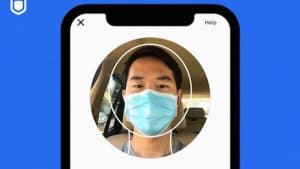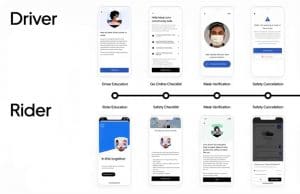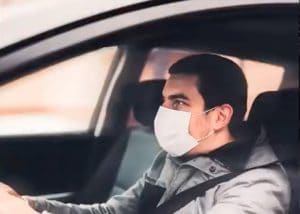
Uber drivers are now required to wear masks and take a picture of themselves to riders can see that they’re following protocol.
(c) 2020 TheDetroitBureau.com
Uber now will require drivers and delivery workers, as well as passengers, to wear masks, one in a series of steps the ride-sharing service is taking to both minimize the spread of the coronavirus and to win back customers who may be worried about the risks posed by getting into a vehicle that might previously have been used by someone with the disease.
“Things are going to look a little different for both riders and drivers,” Uber CEO Dara Khosrowshahi said during a conference call with reporters.
Things already are looking different for Uber and competitors like Lyft. Prior to the pandemic, ride-sharing services were expected to transform the American transportation system. It was widely anticipated that, over the course of the coming decade, millions of American motorists would either give up their personal vehicles or cut back the size of their household fleets.
(Uber, Lyft post Q1 losses; find bright spots in business.)
As the nation begins to exit the lockdown covering nearly 300 million people such conventional wisdom now seems less certain. The crisis has hammered the finances of both Uber and Lyft who, together, reported more than $3 billion in losses during the first three months of the year, with more red ink expected during the April-June quarter. How deep a deficit they run up will depend upon how well they do drawing back nervous travelers and commuters, but there are warning signs that this won’t be easy.
“How can you feel safe when you’re not sure about what you’re getting into,” whether the driver or previous passenger might have been infected with the coronavirus, Brooklyn resident Jeff Ehoodin asked in an interview with TheDetroitBureau.com.
That was a sentiment echoed by close to a dozen other regular users of ride-sharing services around the country:
- “I’m often in New York,” where photographer Joe Polimeni relies on both mass transit and ride-sharing services. Now, however, he says that, “Until there’s a vaccine, I’d rather walk;”
- “I regularly used Uber while traveling (and) I used to travel a lot,” said Harry Bell, the CEO of a creative services company in Charleston, West Virginia. “I will be very reluctant to travel going forward,” especially if it requires the use of ride-sharing. Instead, Bell hopes to rely on Zoom;
- Michigan’s Richard Halprin is another traveler who liked to use ride-sharing both at home and on the road but, “Going forward, I would have to entirely rethink (my) transportation strategy when visiting big cities where some form of public transportation is the norm and private transportation the rare exception.”
Such concerns are more than anecdotal, a series of new studies raising serious questions about whether ride-sharing services will bounce back any time soon – while also raising questions about riders’ willingness to return to mass transit systems.
Asked about using ride-sharing services after shelter-in-place orders are lifted, 43% of those surveyed by transportation consulting service said they would be using them less often – if at all – due to “health and safety concerns.”
Similar results were found in several other surveys, 26% of those polled by Google saying they will use ride-sharing services less often, 23% saying they will stop all together. IBM, which polled American consumers on a variety of possible post-pandemic changes, found travelers not only likely to slash usage of ride-sharing but mass transit, as well.
“More than 20% of respondents who regularly used buses, subways or trains now said they no longer would, and another 28% said they will likely use public transportation less often,” noted the summary of the IBM report.
While these studies suggest many Americans will still turn to companies like Uber and Lyft, the potential loss of millions of regular customers could prove devastating.
At the very least, the pandemic “is going to set (ride-sharing) back a number of years and shake out some entries,” said J.D. Power senior analyst Tyson Jominy in an interview. The problem for many potential users is that “getting into someone else’s car might seem frightening. Who knows when it was last cleaned?”
The two companies have already responded with big job cuts, Lyft on April 29 laying off 17% of its workforce and furloughing hundreds more. Uber followed a week later by eliminating 14% of its staff, about 3,700 workers in all.
(Lyft surpasses autonomous rides milestone.)
Drivers have been especially hard hit. Ron Hroncich spent four years running around the St. Petersburg, Florida region for Uber, but in early March, in the middle of the busy season, “It began to slow down and by the third week of March I couldn’t make any money because people had stopped flying in.” Even with Florida reopening beaches, Hroncich said, “It’s still not back,” and he believes, “It’s not coming back.”
The two ride-share giants, Uber and Lyft, are determined to prove him wrong.
“With guidance from the CDC and local officials, Lyft is taking action to build products and implement policies that help keep riders and drivers safe,” Angie Westbrock, vice president of Global Operations and head of Lyft’s COVID-19 Response Task Force, said in a statement sent to TheDetroitBureau.com. “We want these new initiatives to have a meaningful impact and set a new standard for rideshare health safety.”
Like its bigger rival, Lyft will require both drivers and passengers to agree to wear face masks at all times in one of its vehicles. Uber safety chief Sachin Kansal told CNN Business that “If the driver approaches and the rider sees the driver is not wearing a mask, they can cancel the trip. They don’t have to get in the car.”
Both rider and driver also will have to self-certify that they are symptom-free – though with many of those infected with COVID-19 showing no symptoms that is no guarantee they won’t spread the coronavirus.
Whether such moves will be enough to win back riders is far from certain. The problem is that it will be difficult to ensure every possible touchpoint in a shared vehicle – including taxis and limos – has been properly sanitized, analysts stressed. But that could open up opportunities for other forms of mobility, or so hopes Kyle Rowe, head of government partnerships for Spin, the scooter rental company acquired by Ford in 2018.
“We have fewer touchpoints, really only the handlebar, a lot fewer than you have in a vehicle where another customer might have been in before you,” said Rowe in a telephone interview.
For his part, Brooklyn’s Ehoodin agrees, saying he’d be more comfortable on a rental scooter or bike because, “You can disinfect the handlebar and grips with something you can carry around in your pocket.”
While the pandemic clearly poses big risk to shared mobility services, it might actually prove to be a boon to the auto industry. A study by Cars.com found 93% of motorists expecting to use their own vehicles more as they turn less to ride-sharing and public transportation. Notably, 20% of the respondents who don’t own cars now are considering purchasing a vehicle.
Tellingly, data gathered over the last two months has found that the Millennials and Gen-Z cohorts who had long stayed out of the car market were unusually active during the pandemic lockdown.
(Waymo restarting autonomous vehicle testing in Phoenix.)
While sales were down by nearly half in April that was far less than the 80% decline Power and others had forecast, and It was “the younger demographics who held up the market,” said analyst Jominy. Those same, under-35 consumers have tended to be the most active users of ride-sharing up until now. So, the fact that many are now getting new vehicles could turn out to be a warning of hard times to come for companies like Uber and Lyft.




